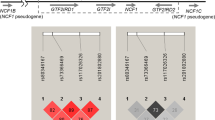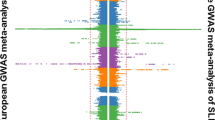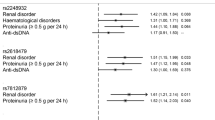Abstract
We evaluated the roles of five single-nucleotide polymorphisms (SNPs) within PDCD1, and haplotypes defined by these SNPs, for the development of systemic lupus erythematosus (SLE) and specific sub-phenotypes (nephritis, antiphospholipid antibody positive, arthritis and double-stranded DNA positive) within a multiethnic US cohort of 1036 patients. Family based analyses were performed using 844 simplex families from four ethnic groups (Caucasian, Asian, Hispanic and African American). Subjects were genotyped for five ‘tag’ SNPs (selected from 15) to provide complete genetic information in all main ethnic groups. We employed transmission disequilibrium testing to assess risk for SLE by allele or haplotype, and multiple logistic regression analysis of SLE cases to examine associations with specific sub-phenotypes. In family based analyses, a haplotype containing the PD1.3A allele was significantly associated with SLE susceptibility among Caucasian families (P=0.01). Among Hispanic families, two novel SNPs were associated with SLE risk (P=0.005 and 0.01). In multivariate logistic regression analyses, five haplotypes were associated with specific sub-phenotypes among the different ethnic groups. These results suggest that PDCD1 genetic variation influences the risk and expression of SLE and that these associations vary according to ethnic background.
This is a preview of subscription content, access via your institution
Access options
Subscribe to this journal
Receive 6 digital issues and online access to articles
$119.00 per year
only $19.83 per issue
Buy this article
- Purchase on Springer Link
- Instant access to full article PDF
Prices may be subject to local taxes which are calculated during checkout


Similar content being viewed by others
References
Tsao BP . Update on human systemic lupus erythematosus genetics. Curr Opin Rheumatol 2004; 16: 513–521.
Lindqvist A-KB, Steinsson K, Johanneson B, Kristjansdottir H, Arnasson A, Grondal G et al. A susceptibility locus for human systemic lupus erythematosus (hSLE1) on chromosome 2q. J Autoimmun 2000; 14: 169–178.
Magnusson V, Lindqvist AK, Castillejo-Lopez C, Kristjansdottir H, Steinsson K, Grondal G et al. Fine mapping of the SLEB2 locus involved in susceptibility to systemic lupus erythematosus. Genomics 2000; 70: 307–314.
Nishimura H, Nose M, Hiai H, Minato N, Honjo T . Development of lupus-like autoimmune diseases by disruption of the PD-1 gene encoding an ITIM motif-carrying immunoreceptor. Immunity 1999; 11: 141–151.
Nishimura H, Minato N, Nakano T, Honjo T . Immunological studies on PD-1 deficient mice: implication of PD-1 as a negative regulator for B cell responses. Int Immunol. 1998; 10: 1563–1572.
Prokunina L, Castillejo-Lopez C, Oberg F, Gunnarsson I, Berg L, Magnusson V et al. A regulatory polymorphism in PDCD1 is associated with susceptibility to systemic lupus erythematosus in humans. Nat Genet 2002; 32: 666–669.
Prokunina L, Gunnarsson I, Sturfelt G, Truedsson L, Seligman VA, Olson JL et al. The systemic lupus erythematosus-associated PDCD1 polymorphism PD1. 3A in lupus nephritis. Arthritis Rheum 2004; 50: 327–328.
Johansson M, Arlestig L, Moller B, Rantapaa-Dahlqvist S . Association of a PDCD1 polymorphism with renal manifestations in systemic lupus erythematosus. Arthritis Rheum 2005; 52: 1665–1669.
Sanghera DK, Manzi S, Bontempo F, Nestlerode C, Kamboh MI . Role of an intronic polymorphism in the PDCD1 gene with the risk of sporadic systemic lupus erythematosus and the occurrence of antiphospholipid antibodies. Hum Genet 2004; 115: 393–398.
Nath SK, Kelly JA, Harley JB, Scofield RH . Mapping the systematic lupus erythematosus susceptibility genes. Methods Mol Med 2004; 102: 11–29.
Kong EK, Prokunina-Olsson L, Wong WH, Lau CS, Chan TM, Alarcon-Riquelme M et al. A new haplotype of PDCD1 is associated with rheumatoid arthritis in Hong Kong Chinese. Arthritis Rheum 2005; 52: 1058–1062.
Pollak VE, Kant KS . Systemic lupus erythematosus and the kidney. In: Lahita RG (ed). Systemic Lupus Erythematosus. John Wiley & Sons: New York, 1987.
Schur P . Clinical features of SLE. In: Kelley WN, Harris ED, Ruddy S, Sledge CB (eds). Textbook of Rheumatology, 3rd edn. WB Saunders Company: Philadelphia, PA, USA, 1989.
Merrill JT . Antibodies and clinical features of the antiphospholipid syndrome as criteria for systemic lupus erythematosus. Lupus 2004; 13: 869–876.
Ferreiros-Vidal I, Gomez-Reino JJ, Barros F, Carracedo A, Carreira P, Gonzalez-Escribano F et al. Association of PDCD1 with susceptibility to systemic lupus erythematosus: evidence of population-specific effects. Arthritis Rheum 2004; 50: 2590–2597.
Bennet AM, Alarcon-Riquelme M, Wiman B, de Faire U, Prokunina-Olsson L . Decreased risk for myocardial infarction and lower tumor necrosis factor-alpha levels in carriers of variants of the PDCD1 gene. Hum Immunol 2006; 67: 700–705.
Tan EM, Cohen AS, Fries JF, Masi AT, McShane DJ, Rothfield NF et al. The 1982 revised criteria for the classification of systemic lupus erythematosus. Arthritis Rheum 1982; 25: 1271–1277.
Yang N, Li H, Criswell LA, Gregersen PK, Alarcon-Riquelme ME, Kittles R et al. Examination of ancestry and ethnic affiliation using highly informative diallelic DNA markers: application to diverse and admixed populations and implications for clinical epidemiology and forensic medicine. Hum Genet 2005; 118: 382–392.
Barrett JC, Fry B, Maller J, Daly MJ . Haploview: analysis and visualization of LD and haplotype maps. Bioinformatics 2005; 21: 263–265.
Hinds DA, Stokowski RP, Patil N, Konvicka K, Kershenobich D, Cox DR et al. Matching strategies for genetic association studies in structured populations. Am J Hum Genet 2004; 74: 317–325.
Stephens M, Smith NJ, Donnelly P . A new statistical method for haplotype reconstruction from population data. Am J Hum Genet 2001; 68: 978–989.
Stephens M, Donnelly P . A comparison of bayesian methods for haplotype reconstruction from population genotype data. Am J Hum Genet 2003; 73: 1162–1169.
Horvath S, Xu X, Laird NM . The family based association test method: strategies for studying general genotype – phenotype associations. Eur J Hum Genet 2001; 9: 301–306.
Lange C, DeMeo D, Silverman EK, Weiss ST, Laird NM . PBAT: tools for family-based association studies. Am J Hum Genet 2004; 74: 367–369.
Acknowledgements
Mexican Amerindians from the Mazateco area in the State of Guerrero, South Eastern Mexico were kindly provided by Dr Julio Granados Arriola (Department of Immunology and Rheumatology, Instituto Nacional de Ciencias Médicas y Nutrición ‘Salvador Zubirán’, México City, INCMNSZ). This work was supported by NIH R01 AR44804, K24 AR02175, ES09911, T32 DK07219, the Arthritis Foundation and the Mary Kirkland Center for Lupus Research. This work was also supported by grants from the Alliance for Lupus Research (to MEAR), The Swedish Research Council, the Swedish Association Against Rheumatism, the Magnus Bergwalls Foundation, The Gustaf V:e 80-Year Jubilee Foundation, the Marcus Borgströms Foundation and the Torsten and Ragnar Söderbergs Foundation. MEAR is a Research Fellow from the Royal Swedish Academy of Sciences supported by a grant from the Knut and Alice Wallenberg Foundation, Sweden. These studies were performed in part in the General Clinical Research Center, Moffitt Hospital, University of California, San Francisco, with funds provided by the National Center for Research Resources, 5 M01 RR-00079, US Public Health Service.
Author information
Authors and Affiliations
Corresponding author
Rights and permissions
About this article
Cite this article
Thorburn, C., Prokunina-Olsson, L., Sterba, K. et al. Association of PDCD1 genetic variation with risk and clinical manifestations of systemic lupus erythematosus in a multiethnic cohort. Genes Immun 8, 279–287 (2007). https://doi.org/10.1038/sj.gene.6364383
Received:
Revised:
Accepted:
Published:
Issue Date:
DOI: https://doi.org/10.1038/sj.gene.6364383
Keywords
This article is cited by
-
Variants in BANK1 are associated with lupus nephritis of European ancestry
Genes & Immunity (2021)
-
Programmed death 1 ligand (PD-L1) in solid cancers after allogeneic hematopoietic stem cell transplantation: a retrospective analysis by the Nagasaki Transplant Group
International Journal of Hematology (2020)
-
Impact of C4, C4A and C4B gene copy number variation in the susceptibility, phenotype and progression of systemic lupus erythematosus
Advances in Rheumatology (2019)
-
Contraception in Systemic Lupus Erythematosus (SLE)
Current Treatment Options in Rheumatology (2019)
-
PD-1 genotype of the donor is associated with acute graft-versus-host disease after HLA-identical sibling donor stem cell transplantation
Annals of Hematology (2018)



